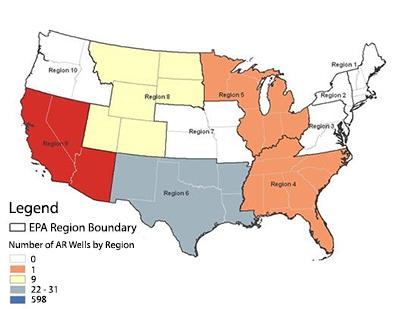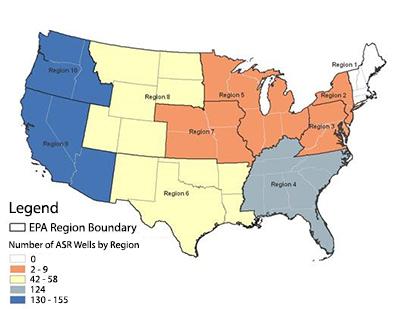Aquifer Recharge and Aquifer Storage and Recovery
On this page:
- Background
- UIC regulations for aquifer recharge and aquifer storage and recovery wells
- Inventory and geographic distribution
- Impacts on underground sources of drinking water
Artificial recharge (AR) and aquifer![]() aquiferAn aquifer is a geological formation or group of formations or part of a formation that is capable of yielding a significant amount of water to a drinking water well or spring. storage and recovery (ASR) are processes that convey water underground. These processes replenish ground water stored in aquifers for beneficial purposes. Although the terms are often used interchangeably, they are separate processes with distinct objectives.
aquiferAn aquifer is a geological formation or group of formations or part of a formation that is capable of yielding a significant amount of water to a drinking water well or spring. storage and recovery (ASR) are processes that convey water underground. These processes replenish ground water stored in aquifers for beneficial purposes. Although the terms are often used interchangeably, they are separate processes with distinct objectives.
• AR is used solely to replenish water in aquifers
• ASR is used to store water which is later recovered for reuse
Explainations follow of:
- General AR and ASR practices
- EPA UIC program regulation of these practices
Background
Water suppliers seek ways to supplement water sources because of increased demand and local weather changes. For these reasons water suppliers and states are evaluating ASR technology. Objectives of ASR projects are to:
- Store water when it is readily available
- Recover water during dry or high demand periods
ASR projects are increasing in number nationwide, especially in areas with potential water shortages. Several methods of introducing water into an aquifer exist. Conventional methods of AR and ASR include:
- Surface spreading
- Infiltration pits and basins
- Injection wells
Injection wells are used for AR and ASR in areas where surface infiltration is impractical. EPA’s UIC program reulates AR and ASR injection wells.
The sole objective of AR wells is to replenish the water in an aquifer. Injecting water through AR wells can:
- Prevent salt water intrusion into freshwater aquifers
- Control land subsidence
In contrast, ASR wells are used to:
- Store water in the ground
- Recover the stored water using the same well or nearby injection and recovery wells
ASR wells inject and recover water for:
- Drinking water supplies
- Irrigation
- Ecosystem restoration projects (such as the Comprehensive Everglades Restoration Project in Florida)
ASR includes production of the injected water. The UIC program does not regulate water production.
AR and ASR wells are frequently found in areas of the United States that have:
- High population density and proximity to intensive agriculture
- Dependence and increasing demand on ground water for drinking water and agriculture
- Limited ground or surface water availability
Construction of AR and ASR wells varies depending upon site-specific conditions and project objectives. Wells may either:
- Be a deep pit draining into porous layers above an underground source of drinking water (USDW)
- Use multiple layers of casing and tubing to inject water under pressure directly into a USDW
UIC regulations for AR and ASR wells
EPA and states regulate AR and ASR wells as Class V injection wells. AR and ASR well owners or operators submit basic well information to either EPA or the state. EPA may directly implement a program, or a state may have primary enforcement authority, or "primacy."
The well is typically authorized by rule if both:
- The owner or operator submits the well information
- The well injection does not endanger a USDW
However, a primacy state or EPA may require an individual permit. Individual permits include operating requirements to ensure USDW protection.
Additional regulations adopted by primacy states for AR and ASR wells vary. State-specific AR and ASR regulations do not supersede federal regulations that prohibit USDW endangerment.
As of 2007, nine states require water used for AR and ASR injection be potable or treated to national or state standards. Potable water is defined differently in each state. Generally, "potable" refers to water of high quality posing no health risk when consumed.
Some primacy states allow additional types of water to be used in AR and ASR, including:
- Treated effluent
- Untreated surface and ground water
- Reclaimed water
These water sources are subject to state AR and ASR regulations or state water criteria. However, state-specific AR and ASR regulations cannot be less stringent that federal regulations. Specifically:
“no owner or operator shall construct, operate, maintain, convert, plug, abandon, or conduct any other injection activity in a manner that allows the movement of fluid containing any contaminant into underground sources of drinking water, if the presence of that contaminant may cause a violation of any primary drinking water regulation under 40 CFR part 142 or may otherwise adversely affect the health of persons.” (40 CFR 144.12L)
Inventory and geographic distribution
The distribution of AR and ASR wells in the United States varies. Northeastern and midwestern states with relatively abundant drinking water may have not used AR and ASR widely. However, in many southeast, southwest and western states, ASR is a popular option to provide a reliable water supply.
As of 2009, approximately 1,200 AR and ASR wells existed nationwide (see Table 1 and Figures below). Most of the ASR wells are located in coastal areas in EPA Regions 4, 9, and 10. The majority of AR wells are located in EPA Region 9. The number of AR and ASR wells more than quadrupled between 1999 and 2009. ASR and AR wells have been gaining attention as important water management tools in recent years. There have likely been additional changes in the national inventory and distribution since the time this analysis was conducted.
| Well Type |
Capable of Operation |
Non- Functional |
Plugged & Abandoned |
Project Sites Containing Wells |
|---|---|---|---|---|
| ASR | 542 | 14 | 65 | 307 |
| AR | 661 | 0 | 375 | 441 |
| Total | 1203 | 14 | 440 | 748 |
 Figure 1a: Distribution of aquifer recharge wells by EPA Region.
Figure 1a: Distribution of aquifer recharge wells by EPA Region.
 Figure 1b: Distribution of Aquifer Storage and Recovery Wells by EPA Region
Figure 1b: Distribution of Aquifer Storage and Recovery Wells by EPA Region
Impact on underground sources of drinking water
Water injected into AR and ASR wells includes:
- Drinking water from a public water treatment system
- Untreated ground water and surface water
- Treated effluent
- Reclaimed or recycled water
These water sources are subject to state AR and ASR regulations or state water criteria. Nine states require that water used for ASR injection be potable or meet national or state drinking water standards.
Each state defines potable water differently. Potable water generally refers to water of high quality that poses no health risk when consumed.
Some primacy states allow additional types of water for ASR use.
The type and quality of injected fluid, called "injectate," and the geology affect the potential for endangering a USDW. The following examples illustrate potential concerns.
- If injectate is not disinfected pathogens may enter an aquifer. Some states allow injection of raw water and treated effluent. In these states, the fate of microbes and viruses in an aquifer is relevant.
- When water is disinfected prior to injection, disinfection byproducts can form in situ. Soluble organic carbon should be removed from the injectate before disinfection. If not, a chlorinated disinfectant may react with the carbon to form contaminating compounds. These contaminants include trihalomethanes and haloacetic acids.
- Chemical differences between the injectate and the receiving aquifer may create increased health risks when arsenic and radionuclides in the geologic matrix interact with injectate having a high reduction-oxidation potential.
- Carbonate precipitation in carbonate aquifers can clog wells when the injectate is not sufficiently acidic.
EPA did a study of Class V wells in 1999. The study did not identify cases of USDW contamination by AR and ASR wells. Since 1999, EPA lowered the drinking water standard for arsenic to 0.01 milligrams per liter. Testing at some ASR operations in the 1999 study showed concentrations of arsenic exceeding the current standard.
Some tested ASR operations had manganese and iron concentrations exceeding National Secondary Drinking Water Regulations. Additionally, the presence of disinfection byproducts has occurred in USDWs due to ASR activities. EPA is not aware of exceedances of applicable primary drinking water standards.
AR and ASR injection can have positive impacts on USDWs. Recharge into aquifers of poor quality water has, in some cases, improved ambient water quality.
